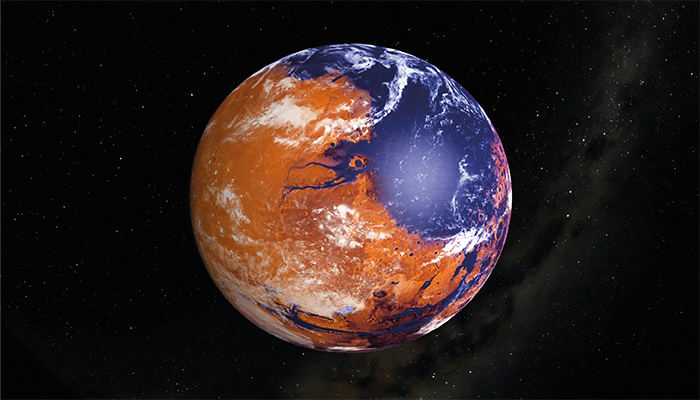
This is an artist's concept of an early Mars with liquid water (blue areas) on its surface. Ancient regions on Mars bear signs of abundant water - such as features resembling valleys and deltas, and minerals that only form in the presence of liquid water. Scientists think that billions of years ago, the atmosphere of Mars was much denser and warm enough to form rivers, lakes, and perhaps even oceans of water. As the planet cooled and lost its global magnetic field, the solar wind and solar storms eroded away to space a significant amount of the planet’s atmosphere, turning Mars into the cold, arid desert we see today.
New isotopic data from Mars has revealed that ancient carbonates found in Gale Crater formed under extreme environmental conditions, providing insight into how the planet's once water-rich climate became the inhospitable desert it is today. The findings, made using NASA’s Curiosity rover, suggest a shift between wet–dry cycles and frigid, cryogenic environments.
The isotopic analysis conducted by the Sample Analysis at Mars (SAM) tunable laser spectrometer (TLS) revealed high levels of carbon-13 and oxygen-18 – the most enriched isotopic signatures ever recorded for Martian materials. “The isotope values of these carbonates point toward extreme amounts of evaporation, suggesting that these carbonates likely formed in a climate that could only support transient liquid water,” explained David Burtt, lead author of the study from NASA’s Goddard Space Flight Center, in a press release. The heavy isotope values observed were 2–3 times higher than those typically seen in carbonates on Earth, suggesting that the processes driving isotopic fractionation were taken to an extreme on Mars.
According to the researchers, this isotopic enrichment is likely the result of two major formation mechanisms: evaporation-driven Rayleigh fractionation (where lighter isotopes escape as water evaporates) and cryogenic brine precipitation (which occurs under cold, salty conditions). “These formation mechanisms represent two different climate regimes that may present different habitability scenarios,” said Jennifer Stern, co-author of the study from NASA Goddard, in the press release. “Wet–dry cycling would indicate alternation between more-habitable and less-habitable environments, while cryogenic temperatures in the mid-latitudes of Mars would indicate a less-habitable environment where most water is locked up in ice and not available for chemistry or biology.”
The data supports theories that Mars once had periods of intermittent liquid water, likely during transient wet conditions, but that much of its later climate was dominated by cold and salty environments, locking most of the water away in ice. The isotopic findings add new evidence to previously proposed climate models of ancient Mars, bolstering the view that the planet went through significant climatic shifts before becoming the cold, arid world it is today.
As for life on Mars? The carbonates analyzed in this study do not indicate an ancient biosphere, but they do suggest that Mars may have hosted transient environments that could have supported life at some point in its history.




